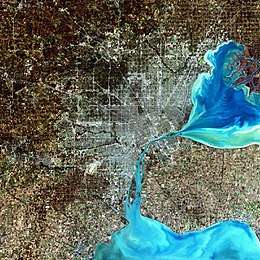University of Michigan–Dearborn
The University of Michigan–Dearborn (U of M Dearborn, UM–Dearborn, or UMD) is a public university in Dearborn, Michigan. It is one of the two regional campuses of the University of Michigan operating under the policies of the Board of Regents. The University of Michigan in Ann Arbor is located 35 miles to the west; the other regional campus is in Flint, which is located 70 miles to the north.
 | |
Former names | Dearborn Center of the University of Michigan |
|---|---|
| Motto | Arts, Knowledge, Truth |
| Type | Public |
| Established | 1959 |
Parent institution | University of Michigan |
| Endowment | US $56 million |
| Chancellor | Domenico Grasso |
| President | Mark Schlissel |
Academic staff | 511 |
| Students | 9,468 [1] |
| Undergraduates | 7,185 [1] |
| Postgraduates | 2,191 [1] |
| 92 [1] | |
| Location | , , United States |
| Campus | Suburban 200+ acres |
| Colors | Maize and Blue[2] |
| Nickname | Wolverines[3] |
Sporting affiliations | NAIA ACHA Wolverine-Hoosier Athletic Conference Great Lakes Collegiate Hockey League |
| Website | umdearborn |
 | |
Enrolled students have full access to the library systems, galleries, and sporting events of the main campus, and graduates are members of the largest alumni organization of its kind in the world, the University of Michigan Alumni Association. Faculty and students collaborate across all three campuses in research and scholarly activity, and degrees for all three campuses are conferred by the state elected Board of Regents.
UM-Dearborn offers over 100 academic majors and minors, 43 masters degree programs, and 6 doctoral degree/specialist programs. A part of the Metro Detroit region, UMD is also known for its community engagement within the city of Detroit, and is part of The Coalition of Urban and Metropolitan Universities.[4]
History
The first movement toward what was to become The University of Michigan–Dearborn began with some studies in the middle 1950s of manpower supply conducted by Archie Pearson, director of training for Ford Motor Company. Convinced that serious shortages were looming for the Company in qualified, college-trained engineers and junior administrators, he made discreet inquiries of educational institutions in the Detroit area concerning their willingness to adjust their programs to meet these needs.
The announcement on December 17, 1956 of a gift of land and capital development money from the Company to the University made it obvious that the focus of the agreement between the two was the building of an upper-division and master's level campus of the University which would adopt the cooperative work-study requirement as a part of its regular degree program in engineering and business administration. The University was to provide the regular professional and liberal arts courses necessary to a University of Michigan bachelor's or master's degree, with the co-op work assignments forming an integral addition to the regular academic requirements. UM-Dearborn opened as the Dearborn Center of the University of Michigan on September 28, 1959.
The 1969 report of the Dearborn Campus Planning Study Committee, appointed by University Vice President for State Relations and Planning Arthur Ross to consider the future of the campus, recommended the addition of the first two years to become a full four-year institution and the expansion of non-coop programs; it recommended other changes as well, most of which were implemented in 1971 to give the campus its present structure. It became at that time a four-year undergraduate institution (newly designated "The University of Michigan-Dearborn") with a continued commitment to some master's level graduate programs, having a Chancellor as its chief executive officer; two years later, the old divisions became schools and colleges, and the Division of Education ("Urban Education" for the first few years) was created, with each of the major academic units headed by a dean. The first Chancellor of the UM-Dearborn, Dr. Leonard E. Goodall, was appointed in July, 1971. After that watershed change in 1971, UM-Dearborn grew rapidly from just under 1,000 students to over 6,000 in 1979.
During this period there was a scramble just to supply the courses and facilities needed to accommodate the soaring student population. New faculties were added at the rate of 10 to 20 per year, and the face of the campus changed as a new set of buildings (the former University Mall now remodeled as the University Center, the Fieldhouse, and the Library) was planned and constructed to the south of the original four buildings. By April 1981, when the new library building was dedicated, the population center of the campus had shifted to this newly developed area. Ironically, however, these years of expansion also ushered in a period of severe retrenchment, when the debt burden of the new structures coincided with a recession and cuts in state aid to the campus. Dr. William Jenkins, appointed as UM-Dearborn's second Chancellor in 1980, took the helm at the beginning of what may be called the institution's "Years of Consolidation."
Several developments in campus organization, administrative personnel, and academic offerings have highlighted what might be called the "Years of Redirection," from about the time of the inauguration of Chancellor Blenda Wilson (1988). At the center of this "redirection" has been a program of strategic planning, initiated in the summer of 1990 and reinforced by planning retreats for the whole campus in the fall terms of 1990, 1991 and 1992. A new campus mission statement arose out of the first retreat which articulates UM-Dearborn's commitment to providing an experience of academic excellence for a diverse body of students from the metropolitan Detroit area, encouraging full community attention to the traditions of free intellectual inquiry, critical thinking and ethical behavior through interactive teaching, research, creative and applied scholarship, and service. From the second retreat emerged the principal points of a set of learning goals for undergraduate students.
Under Chancellor Little (2000), the campus community reaffirmed its intention to pursue doctoral programming, to explore the possibility of on-campus housing, to review undergraduate programs and to focus attention on diversity. The most recent self-study for continuing accreditation by the Higher Learning Commission (formerly the North Central Association) focused on each of these areas and provided summaries of the current status of each of these ongoing efforts. UM-Dearborn was accredited for ten years in 2004 and was authorized to offer doctoral programming.
In the spring of 2008, facility planners at University of Michigan Dearborn began to consider adding a dormitory building to the campus for undergraduate students. Up to that point, the school had been only been a commuter school.[5] The school's consultant, Brailsford & Dunlavey, issued an online survey to gain information about what the students felt would be the best option. The proposed dormitory would be aimed at encouraging students to stay on campus full-time to provide a better college environment feel. The aim would also be to gain additional students from around the state and country. The addition of dorms could also serve to ease the parking situation which has become a large problem for students especially in the peak hours for class. On January 28, 2011, local reporter Jessica Carreras tweeted that student housing would be built in old office buildings just east of the university's main campus.[6] In 2012 groundbreaking for the privately owned apartment complex began. A private-public partnership resulted in The Union at Dearborn, which officially opened in September 2013.[7]
In November 2008, the University of Michigan board of regents approved the establishment of Ph.D programs in information systems engineering and automotive systems engineering in the UM–Dearborn College of Engineering and Computer Science beginning in Fall 2009. In February 2009, the regents approved an Ed.D. program at the UM-Dearborn School of Education, designed to provide the citizens of southeastern Michigan with a program that is well-matched to the economic, social and political challenges that face our region. In 2009, UM-Dearborn welcomed its fourth Provost and Vice Chancellor for Academic Affairs, Dr. Catherine A. Davy. Two new buildings, the Science Learning and Research Center (just west of the Science Building) and the Institute for Advanced Vehicle Studies are now operational.
In August 2018, UM-Dearborn welcomed its sixth chancellor, Domenico Grasso. He also serves as professor of public policy and administration and professor of sustainable engineering at UM-Dearborn.[8]
Campus
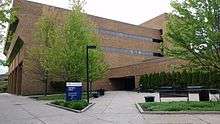
The campus, located at the former estate of automotive pioneer Henry Ford, is divided into several sections: The Henry Ford Estate, known as Fair Lane, The Fairlane Center, Main Campus, and the Early Childhood Education Center just south of campus. In addition, the University has over 70 acres (283,000 m²) of nature preserve and a bird observatory, the Rouge River Bird Observatory , which has operated on campus since its founding in 1992, and is the longest-running, full-time urban bird research station in North America.[9]
Main Campus includes the facilities for the College of Arts, Sciences, and Letters (CASL), the College of Engineering and Computer Science (CECS), the Environmental Interpretive Center, Administration, the Mardigian Library, the Institute for Advanced Vehicle Studies, the University Center, the Computing Building, and the Fieldhouse. Within both CASL and CECS, many different buildings house different programs, departments, research centers, student life centers, and academic resources.
Fair Lane
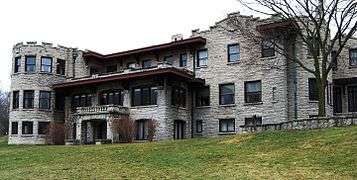
Fair Lane and the nature preserve west of campus are along the Rouge River. There is a small waterfall, rose garden, meadow, a lake, and reflecting pond surrounded by acres of forest. The forest has many walking paths which connect the Environmental Interpretive Center, Henry Ford Community College, Downtown West Dearborn, Hines Drive, the University's Main Campus, and Fair Lane together. Fair Lane recently has been handed over to Edsel and Eleanor Ford House. The Edsel Ford Estate will put forth restoration efforts which will cost 50 million dollars or more. The majority of the funding will go towards full home restoration and grounds preservation. The project will open up rooms which had been unavailable to public tours before.
Academics
There are four colleges at UMD: the College of Arts, Sciences, & Letters (CASL), the College of Engineering & Computer Science (CECS), the College of Business (COB), and the College of Education, Health, & Human Services (CEHHS).
College of Arts, Sciences, & Letters
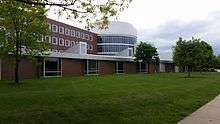
The College of Arts, Sciences, & Letters (CASL), pronounced "castle," is home to five graduate programs, 32 undergraduate majors, and programs in environmental sciences, mathematics, applied statistics, physical sciences, religious diversity, cultural studies, health policy studies, health psychology, civic engagement, and leadership.
The main building houses the College's administrative offices and the departments of Behavioral Sciences, Mathematics and Statistics, Literature Philosophy Arts (LPA) and Language Culture and Communication (LCC). General purpose classrooms occupy the majority of the first level, along with the campus television studio. Several other programs, such as urban studies and criminal justice, are housed in different buildings spread across campus.
College of Engineering & Computer Science
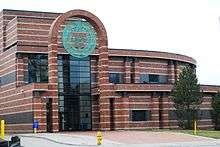
The College of Engineering and Computer Science (CECS) is home to nine undergraduate degree programs and twelve graduate degree programs, including two doctoral programs, housed in CIS, ECE, ME, IMSE departments and college Interdisciplinary Programs.
College of Business
The COB offers undergraduate and graduate programs.
College of Education, Health, & Human Services
The College of Education, Health, & Human Services (CEHHS) offers undergraduate, master's, and doctoral programs. It also offers certificate programs for future and current teachers and opportunities for its students in the Early Childhood Education Center (ECEC).
Athletics
University of Michigan–Dearborn athletic teams are known as the Wolverines, and their colors are Maize and Blue. UM-Dearborn is a member of the National Association of Intercollegiate Athletics (NAIA), primarily competing in the Wolverine–Hoosier Athletic Conference (WHAC). Men's sports include basketball, cross country, ice hockey, soccer, baseball, and lacrosse; while women's sports include basketball, cross country, soccer, softball and volleyball. Men's and women's bowling, along with women's ice hockey will be added for the 2018-19 academic year.
The University of Michigan-Dearborn Fieldhouse serves as the home to many of the athletic and recreational activities on campus. The venue host home contests for men's and women's basketball, men's and women's ice hockey and volleyball. A new hardwood floor was installed in the gymnasium during the summer of 2016.
Championships:
- 1980 – Men's Ice Hockey (runner-up) – NAIA
- 1983 – Men's Ice Hockey (runner-up) – NAIA
- 1984 – Men's Ice Hockey (runner-up) – NAIA
- 1992 - Men's Ice Hockey Conference Champions - CSCHL
- 1992 – Men's Ice Hockey (runner-up) – ACHA Division I
- 1993 - Men's Ice Hockey Conference Champions - CSCHL
- 1998 - Men's Ice Hockey Conference Champions - CSCHL
- 1998 - Men's Ice Hockey Conference Tournament Champions - CSCHL
- 1999 - Men's Ice Hockey Conference Champions - CSCHL
- 2008 - Men's Rugby State Champions Div II Tier II
- 2016 - Men's Ice Hockey Conference Tournament Champions - GLCHL
- 2017 - Men's Ice Hockey Conference Tournament Champions - GLCHL
- 2017 - Softball Conference Champions - WHAC
- 2018 - Men's Basketball Conference Tournament Champions - WHAC
- 2018 - Men's Basketball - NAIA Division 2 National Tournament Appearance
- 2019 - Men’s Ice Hockey Conference Champions - WHAC[10]
Student life
There are over 125 recognized student organizations (RSOs) and 9 university sponsored organizations (USOs). Both the RSO and USO communities comprise extraordinary interests, from Greek Life, Academic/Professional Organizations, Cultural and Ethnic Organizations, Honor Societies, Political and Social Activist Organizations, Recreational Organizations, and Religious and Spiritual Organizations.
University sponsored organizations:
- The Michigan Journal, the student newspaper of the University of Michigan–Dearborn since 1971.
- WUMD, the student radio station of the University of Michigan–Dearborn since 1979.
- Campus Video Network
- Greek Leadership Council
- The Lyceum
- Student Activities Board
- Student Government
- Student Organization Advisory Council (SOAC)
- The Wolf Pack
WUMD College Radio is a student-run, free-format radio station that features diversity in music from punk rock to bluegrass, jazz to electronica, and everything in between. Starting in 2007, the station began live broadcasts of UMD sporting events.[11]
|
Fraternities:
|
Sororities:
|
Student body
In Fall 2017, the university had an enrollment of nearly 9,339 students: 7,141 undergraduates and 2,198 graduates. 57% of UM-Dearborn's students are men and 43% are women. 94% of students are State of Michigan residents. 26% are minorities. 50% are first generation college students. Average high school GPA is 3.6. The average SAT score for incoming freshmen is 1,168.[12]
About half of UM-Dearborn's students enter directly from high school; the remainder are students who have prior college experience either immediately before entering UM-Dearborn or at some earlier point in their lives and careers.[13]
Notable alumni and faculty
- Ismael Ahmed – Director of the Michigan Department of Human Services
- Saul Anuzis – Chairman of the Michigan Republican Party
- Mark Atkinson – one of the world's top diabetes researchers
- Susy Avery – Chairman of the Michigan Republican Party
- Ted Casteel – Owner of Bethel Heights Vineyard in the Willamette Valley of Oregon[14]
- George Darany – Former member of the Michigan House of Representatives
- Rima Fakih – Model, actress and Miss USA winner
- Kimberly Frost – Novelist
- Kumar Galhotra – President of Ford North America
- Rudy Hatfield – Professional basketball player of Barangay Ginebra Kings in the PBA
- Ian Hornak — Founding artist of the Hyperrealist and Photorealist fine art movements.[15][16]
- Huda Kattan – Makeup artist, beauty blogger, and founder of cosmetics line Huda Beauty
- Mary Beth Kelly – Former Michigan Supreme Court Justice
- Paul S. Kemp – Novelist
- David Knezek – Former member of the Michigan Senate
- Lesia Liss – Former member of the Michigan House of Representatives
- Trevor Rosen – Member of award winning country music act Old Dominion
- Jason Schmitt – Journalist and academic
References
- "University of Michigan-Dearborn: Facts & Figures". University of Michigan-Dearborn. Retrieved September 3, 2019.
- "Colors | Brand Identity". Retrieved March 8, 2020.
- "The Michigan Journal - UM-Dearborn officially changes name from Wolves to Wolverines". The Michigan Journal.
- http://www.cumuonline.org/membership/index.htm Retrieved September 3, 2010. Archived February 25, 2009, at the Wayback Machine
- "University of Michigan-Dearborn". Brailsford & Dunlavey.
- "Dearborn Patch". Twitter.
- "The Union at Dearborn celebrates grand opening of model room". umdearborn.edu. Retrieved 2019-07-08.
- "Domenico Grasso | Office of the President". president.umich.edu. Retrieved 2020-01-20.
- "Research & Resources - Rouge River Bird Observatory". Retrieved July 17, 2019.
- "2018-19 Championships". Wolverine-Hoosier Athletic Conference. Retrieved 2020-01-20.
- "wumd.org". WMUD. Retrieved September 11, 2011.
- "Facts and Figures". University of Michigan-Dearborn. Retrieved March 2, 2019.
- "Student Profile". University of Michigan-Dearborn. Retrieved September 11, 2011.
- John Winthrop Haeger Pacific Pinot Noir pg 51–53 University of California Press, Berkeley, CA 2008 ISBN 9780520253179
- Stephen Bennett Phillips, Eric Ian Hornak Spoutz, "Ian Hornak Transparent Barricades," exhibition catalogue, Board of Governors of the Federal Reserve System, Fine Art Program, Washington D.C., 2012
- Joan Adan, Eric Ian Hornak Spoutz, "Transparent Barricades: Ian Hornak, A Retrospective," exhibition catalogue, Forest Lawn Museum, Glendale, California, May 2012
